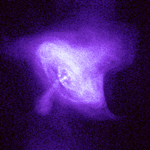Astronomy Fun Fact:A pulsar's magnetic field is so strong that it causes most of the light and radiation that the neutron star emits to be concentrated into cones of emission, like beams from a lighthouse. In fact, the key to a pulsar is the combination of the extraordinary magnetic field and the rotation of a neutron star. If the neutron star is spinning, like the Earth rotates on its axis, and if the Earth happens to lie in the path of the beams, we see a pulse of light each time a beam sweeps across the earth.
Get on the APOD PING list! 
To: MozartLover; Joan912; NovemberCharlie; snowfox; Dawgsquat; viligantcitizen; theDentist; grlfrnd; ...
APOD PING!


A sequence of images showing the flashes at visible wavelengths from the Crab pulsar, located at the center of the Crab Nebula. Credit: National Optical Astronomy Observatories
Here's the Chandra x-ray image of the central part of the Crab.
Chandra's X-ray image of the Crab Nebula directly traces the most energetic particles being produced by the pulsar. This amazing image reveals an unprecedented level of detail about the highly energetic particle winds and will allow scientists to probe deep into the dynamics of this cosmic powerhouse.

To: petuniasevan
The Crab has always been my favorite; seeing it through the eyes of Hubble was interesting, to say the least.
5 posted on
07/14/2002 2:08:01 PM PDT by
AngrySpud
To: petuniasevan; maxwell
Beautiful picture, PT! Thanks!

Hey, Max. Click on the main pic and it will bring up a full resolution pic!
To: petuniasevan
Beautiful!
10 posted on
07/14/2002 4:40:42 PM PDT by
aomagrat
To: petuniasevan
Get on the APOD PING list! Me! Me! Me! Please add me to the APOD ping list!!!! Thanks.
To: petuniasevan
I'll say it again: holy catfish!
13 posted on
07/14/2002 7:05:55 PM PDT by
Joan912
To: petuniasevan
Bumpity-bump.
To: petuniasevan
Gee.. I think I'm especially attracted to Nebula's!! :o)
To: petuniasevan
Hey.. There's waldo!
20 posted on
07/15/2002 6:34:50 PM PDT by
Jhoffa_
FreeRepublic.com is powered by software copyright 2000-2008 John Robinson



